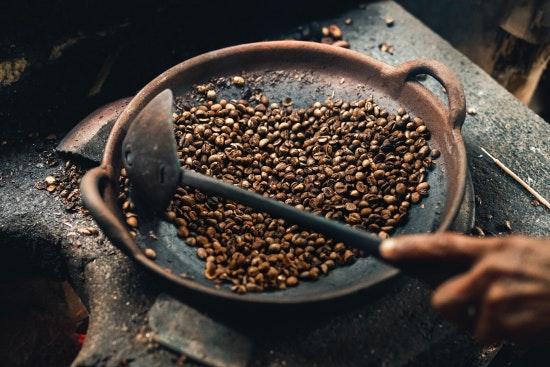Across the globe, coffee is often the first thing people reach for when they get up. However, few people know the different types of coffee beans and how they are grown, processed, and roasted. This guide will provide a detailed overview of the different types of coffee beans, their origins, and how they are processed to create the perfect cup of coffee.

Types of Coffee Beans
Arabica Beans
Arabica beans are the most common coffee bean grown in high altitudes, typically above 3,000 feet. The low acidity and nuanced tastes that these beans are renowned for. Arabica beans are typically grown in countries such as Colombia, Brazil, and Ethiopia and are often used to create specialty coffee blends.
Robusta Beans
Robusta beans, which are cultivated at lower elevations, are often used in inexpensive, mass-produced coffees. These beans are more bitter and contain more caffeine than others. Because of their high crema concentration and bold taste characteristics, robusta beans are often utilized in espresso mixes.
Liberica Beans
Liberica beans are one of the rarest coffee beans and are only grown in small quantities. These beans have a unique, fruity flavor and are typically used in blends to add complexity to the coffee’s flavor profile. Liberica beans are primarily grown in the Philippines, although their cultivation spreads to other countries.
Origins of Coffee Beans
Coffee beans are grown in various regions worldwide, with each region producing unique flavors and characteristics. Some of the most common regions for coffee bean cultivation include:
South America
South American nations like Colombia, Brazil, & Peru are renowned for their production of premium Arabica coffee beans. These beans have a milder flavor profile than their African counterparts and are often used to create specialty coffee blends.
Africa
African countries such as Ethiopia, Kenya, and Tanzania are known for producing high-quality coffee beans with complex flavor profiles. These beans are typically Arabica beans and have high acidity with fruity and floral notes.
Asia
Asian countries such as Indonesia and Vietnam are known for producing Robusta coffee beans. These beans have a strong, bitter flavor and are often used in mass-produced coffees.
Processing Coffee Beans
The process of coffee bean processing varies depending on the region and the type of bean. However, there are two primary methods of coffee bean processing:
Washed Process
The washed process involves removing the outer layers of the coffee bean using water. This process produces a cleaner, brighter flavor profile and is typically used for high-quality beans.
Natural Process
The natural method entails drying coffee beans with their protective skins still attached. This process results in a fruitier, complex flavor profile and is often used for specialty coffee blends.
Roasting Coffee Beans
The process of roasting coffee beans is essential in determining the final flavor profile of the coffee. There are three primary roast levels:
Light Roast
Coffee beans that have been roasted for less time are known as “light roast,” and both their appearance and taste are influenced by this fact. These beans are often used in gourmet coffee concoctions.
Medium Roast
Coffee beans are considered medium-roasted when their roasting time is between that of a light roast and a dark roast. These beans are superior for espresso mixes because of their stronger taste and deeper color.
Dark Roast
The darkest color and most flavorful coffee beans are produced by roasting beans for the longest periods of time. The majority of commercial coffees are using these beans as their main component.
Benefits of Understanding Coffee Beans
Improved Taste
By understanding the different varieties of coffee beans, processing methods, and roasting techniques, you can identify the flavors and aromas that you enjoy in your coffee. This can help you choose the right coffee beans and brewing methods to create a perfect cup of coffee.
Better Quality
By knowing the origin and processing method of your coffee beans, you can ensure that you are buying high-quality beans that are sustainably sourced and ethically produced. This can also help you avoid low-quality beans treated with chemicals or other additives. Green Kona coffee beans are known for their exceptional quality and distinct flavor profile, making them a sought-after choice among coffee enthusiasts looking to expand their understanding and knowledge of coffee.
Conclusion
The history and culture of coffee are intriguing and complicated. To fully enjoy the subtleties and intricacies of a superb cup of coffee, you need to learn about the many types of coffee beans, processing procedures, and roasting techniques. There’s a coffee out there for everyone, whether they like theirs mild and fruity or solid and dark. In other words, the next time you sit down with your morning joe, take a minute to absorb the flavors and think about the art and science that went into producing that cup just right.
